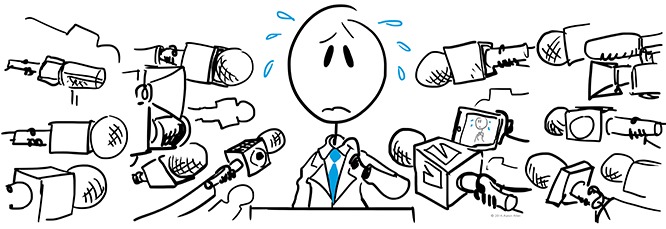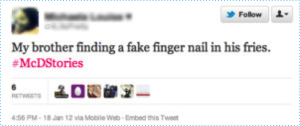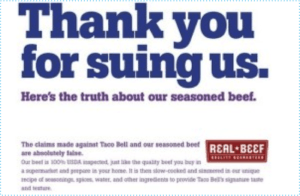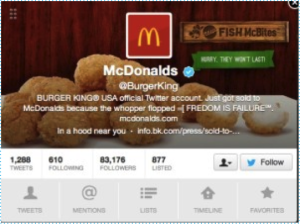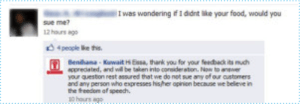Boy, do we love food. But we love scandal even more, it seems. Food plus scandal equals a major crisis, otherwise known as a publicity nightmare. Here, we look at some of the top restaurant crisis communications challenges in history.
A few of these case studies will jog your memory. Remember Wendy’s “finger in the chili” situation? What about Jack in the Box’s E.Coli outbreak? And who could forget Domino’s wayward employees caught on tape? It’s all here, along with other examples of things that will probably keep you awake tonight.
Let’s learn from their mistakes.
We don’t mean to make you nervous, but this is critical. It only takes one person and a six-second Vine clip to bring a multi-billion dollar company to its knees as Golden Corral learned in the summer of 2013. An employee filmed a video of the Port Orange, FL location storing raw meat — ribs, chicken, bacon, and hamburger patties — in the same enclosure as the dumpster, purportedly while preparing for an inspection. Within 24 hours, the video accumulated 25,000 views and is now at 3.9 million views and counting. Franchisee Eric Holm scrambled to undo the damage, but it’s tough to silence a ringing bell.
Restaurant Crisis Communications in Times of a Global Pandemic
COVID-19 is naturally going to be the most critical event shaping the economy and the restaurant industry in the next few years. Multiple factors will coincide to have an irreversible change in the foodservice industry. And in the midst of the worst second quarter in the history of the country, record unemployment and bankruptcies, restaurants should adapt their crisis communications program. This crisis is not isolated to the operators, or the guest, or the employees but also the suppliers and the investors — all the stakeholders are affected.
Here are some tips on how to communicate in the face of a global pandemic:
- Restaurants should recognize how important communications are. Realizing that the pandemic a moment of physical isolation, not social — meaning we should still continue to be in touch (and probably more so even now).
- Understand that there are 360-degrees of caring. Operators should be concerned about their staff and communicating with them: the ones who are there and the ones who are gone.
- Customers don’t want marketing messages, but the pandemic affects the routine of so many people. When you think of a restaurant as part of the routine, the ecosystem of people that work and dine there has been disrupted. So customers want to know what’s happening and what specific steps will be taken to take care of them and employees during re-openings.
- Communication through blogs and social channels can be daily. Some restaurant chains haven’t even updated their websites. So people don’t know if they are closed or just not answering the phone. In some cases, just picking up the phone as you would do with a friend can go a long way with employees, customers, and vendors.
- A tweet doesn’t take any time at all. And there are scheduling tools that would push multiple vehicles at a time. Things are busy but if people are important, restaurants need to find a way to communicate to them that they are important.
One of the lessons that we’ll be reminded of through this pandemic is that this is the hospitality industry, the restaurant business. Part of the spirit of our industry is to express compassion, trust, empathy, care, respect, and service to others. Think it not as a marketing message or a chore, but as something that is in service of others to give them some sense of normalcy. If this isn’t the best time to do it, then when is?
Plans are a Mandatory for Effective Restaurant Crisis Communications
You simply must have a crisis management plan. Don’t court a hellish crisis on the fly. You’re inviting disaster. You also need vigilant and loyal employees and impeccable operating procedures.
Some of these brands in crisis were able to recover. A few, plagued by other issues, folded, because they didn’t respond quickly enough and with the right information. They didn’t have a plan.
1. Denny’s Overcomes Racist Reputation
By the ‘90s, Denny’s had built up a reputation for racism that culminated in 1994 with the $54 million settlement of a class action lawsuit brought by black customers claiming discrimination. It was the largest lawsuit pursued under the Civil Rights Act.
Denny’s poured millions into an anti-racism campaign and education strategy in the mid ‘90s, particularly aiming to educate its employees. It brought on a black-owned company to run numerous franchises and promised to franchise more minority-owned restaurants. Since the early 2000s it’s topped several diversity employment lists and awards and been quick to respond to any cases of racism in its restaurants.
STATS:
- Following the lawsuit, increase of minority officers on board increased from 0 to 11 percent between 1993 and 1996.
- 20 percent minority director positions in 1996 up from 0 in 1993
- 27 African American owned franchises in 1996 up from one in 1993
2. Domino’s Employees Disgust on YouTube
In 2009, Domino’s Pizza discovered that a viral prank video can do a lot of damage. Two employees filmed themselves performing disgusting acts with Domino’s food and posted it to YouTube. Domino’s issued a statement on its website 24 hours after the video was posted, leading to the original video getting more exposure. A survey of brand perception showed Domino’s perception had turned negative after the video.
Two days after the incident, the company posted its own video to social media. In the video, Domino’s president Patrick Doyle apologized for its employees’ actions, saying the two offenders were fired, and assuring the public they were stepping up their food safety vigilance. Domino’s also later created a Pizza Tracker where guests can follow their food in real time from store to home delivery.
The genuine and quick response to the scandal helped Domino’s recover, as well as its emphasis that this was an isolated incident by two employees, not a company-wide attitude. Since then, the Domino’s incident has become a case study of a positive response to a crisis communication situation.
STATS:
- Hundreds of dollars of food were immediately discarded at the Conover, N.C., store where the video was filmed.
- The Conover store later closed due to bad business after the scandal. Surrounding Charlotte, N.C., stores’ sales were also affected.
- The top Google search results for Domino’s referenced the scandal in the days afterwards.
- Video received 700,000 hits in one day.
- 2011 earnings had rebounded after the incident, surpassing analysts’ estimates by 22 percent in its second-quarter earnings.
3. Chi-Chi’s Hepatitis A Outbreak
Mexican restaurant chain Chi-Chi’s was brought down by the largest outbreak of Hepatitis A in U.S. restaurant history in 2003. Already suffering from bankruptcy filing, the Hep A cases knocked out the rest of Chi-Chi’s stamina. Four people died, one needed a liver transplant, and hundreds were sickened. The culprit: Green onions from Mexico that were used to make a mild salsa at the restaurant. While the fault was the suppliers, Chi-Chi’s was not financially solvent enough and did not have enough liability insurance to meet all the claims that came out after the outbreak. Outback eventually bought the remaining Chi-Chi’s and converted or closed them.There are still restaurants in Europe, the Middle East and Indonesia and Chi-Chi’s products are sold in the U.S. But it’s a long fall from the chain’s peak of 230 restaurants.
STATS:
- $6.25-million settlement to man who needed a liver transplant
- $800,000 settlement to a class action lawsuit
4. Jack in the Box E. coli Outbreak
Jack in the Box’s 1993 E. coli outbreak in the Northwest comes up over and over again as a classic communications crisis example. The outbreak from infected meat sickened almost 600 people and killed four, including children. Tens of millions of dollars in profits were lost as a result and it took the restaurant years to recover.
In its first press release on Jan. 18, 1993, three days after it was told E. Coli had been linked to its meat, Jack in the Box initially tried to distance itself from total responsibility, saying other sources could be at fault. A Jan. 21 release however confirmed that it was the restaurant’s meat that was the source of E. coli. The chain soon after pledge to “do everything that is morally right for those individuals who had experienced illness after eating at Jack in the Box restaurants as well as their families.”
The chain switched suppliers, destroyed existing meat, raised meat cooking temperatures, and pledged to pay all medical costs related to the outbreak. This was the first major, public E. coli outbreak in modern U.S. history and led to new food safety laws.
STATS
- 20,000-pounds of destroyed meat
- Foodmaker parent company lost $138 million and Moody’s downgraded debt to junk bond status
- Foodmaker stock dropped 30 percent in immediate aftermath
- $20-30 million in losses total
- 600-plus people sickened, 4 dead
5. Wendy’s Finger in the Chili
Arguably one of the biggest restaurant crisis communications challenges was one woman’s ploy to get money out of Wendy’s, and how it led to one of the most well-known restaurant “scandals” in history. In March 2005, a customer reported she’d found a severed fingertip in her cup of chili at a San Jose Wendy’s. It would later turn out to be a hoax, the finger planted by the guest, who was later found guilty of extortion.
In the meantime, Wendy’s did not respond as well as it could have. It did immediately, in the days after the finger was found, verify that it didn’t come from store employees or a supply problem. It also offered a reward and set up a tipline for finding whoever left the fingertip in the chili. It gave away free food as well.
But Wendy’s was widely thought to have not communicated with its guests or the wider public enough during the crisis. It failed to distance Wendy’s general cleanliness and standards from the hoax. The chain, for example, didn’t offer outside expert verification of Wendy’s store hygiene management. Chili was never removed from the menu even temporarily, which would have been a clear signal the chain was taking the allegation seriously.
STATS
- 2.5 percent sales loss or about $15 million between March 23 and April’s end after crisis
- Approximately $21 million in lost sales total
- Business down by close to 50 percent at some northern California Wendy’s branches
- Some workers laid off and hours cut at other stores
6. #McDStories Twitter Campaign Backfires
McDonald’s thought it had a clever social media campaign on its hands when it launched its #McDStories hashtag and paid Twitter to promote the campaign in January 2012. It was hoping for heartwarming “shared fries with my sister” sorts of tweets. Instead it found its hashtag hijacked by disgruntled McDonald’s guests who had food poisoning stories and ingredient complaints to share.
The campaign only lasted two hours before McDonald’s pulled it. It immediately followed with what it thought was a tamer #littlethings hashtag to try and compensate for the previous Twitter damage.
STATS
- #McDStories was used 1,600 times in two hours
- 68 percent of tweets using hashtag were negative
- McDonald’s stock fell 3 percent four days after the campaign
7. Taco Bell Beef Lawsuit
Taco Bell was sued in 2011 by a guest who said the restaurant chain’s beef was mostly filler. The company quickly rolled out a campaign responding to the lawsuit, which was later dropped.
Taco Bell’s campaign received widespread kudos for countering the “where’s the beef” scandal with a video response, cheeky print and TV ads, food item discount, good social media exposure and a counter suit. There was also a popular free taco Facebook giveaway.
STATS
- $3 million ad campaign
- 88 cent item discount
8. Aijsen Ramen Ribs About Signature Soup
Japanese-based noodle chain Ajisen Ramen is very popular in China and has 600 stores worldwide. But its China stores got hit in 2011, not for food safety issues, but for bad marketing. It had promoted its signature pig-bone soup as being made from scratch using slow-cooked bones in every bowl. In actuality, the soup was mass-produced from a factory-made concentrate.
Ajisen Ramen had also exaggerated the nutritional claims of the soup using a university analysis of its concentrate, not the later diluted soup. In addition, it had earlier been fined $122,000 for using sorbitol in its noodles.
All together, the ingredient revelations led to a tank in stock prices. The company apologized, provided details of its soup base production process. But only vaguely referenced how it planned to regain consumer trust after the incident and could have used a stronger PR push.
STATS
- 50 percent stock drop on Hong Kong stock market in month after ingredient news
- 6.7 percent stock drop in the day after trading resumed following temporary suspension
- UBS AG downgraded Ajisen Ramen stock from “buy” to “hold” and lowered stock target price 35 percent
- 163.com poll found 90 percent of 2,434 people surveyed said controversy affected their decisions on where they’d eat out
9. Burger King’s Twitter Account Hacked
Burger King found that social media can get totally out of control in February when its Twitter account was hacked in one of the most high-profile social media “disaster” cases since the medium’s advent. The hackers changed Burger King’s name to McDonald’s, claimed BK had been bought by the other company, switched its background and profile images, and tweeted odd and drug-related posts for an hour before the account was suspended.
McDonald’s quickly tweeted its innocence saying, “We empathize with our @BurgerKing counterparts. Rest assured, we had nothing to do with the hacking.” And by the end of the day, Burger King had returned its account to normal, tweeting, “Interesting day here at Burger King, but we’re back! Welcome to our new followers. Hope you all stick around!”
Burger King also released a statement within hours of the hack, apologizing for the “erroneous tweets.” While it was an embarrassing episode for the company, it ended up spinning positive with lots of media exposure and gaining more followers. But hopefully the company got a more secure password both for its Twitter account and its social media-related email accounts.
STATS
- Gained 30,000 new followers during hack
- 5,000 new followers in first 30 minutes of hack
- 300 percent increase in Twitter mentions during hack with 450,000 tweets on the topic worldwide
10. What’s In a Name at “Sambo’s”
Sambo’s was a popular mid-19th century pancake chain that refused to see its name as the racist liability it became. The chain’s name came from the two owner’s names combined and used the story of Little Sambo and a tiger because of its connection to pancakes, which the chain was known for. At its peak, Sambo’s had 1,117 restaurants. But a series of lawsuits and protests alleging Sambo’s use of its name was tied to racism began in the ’70s.
While Sambo’s did change the name of several of its restaurants, it was the corporate position that the name was never racist to begin with that showed true hubris. A proposed expansion in Toledo in the late 70s led to Sambo’s suing to use its name in the new restaurants.
There was an innate branding issue. The company would later claim its name was not related to the “Little Black Sambo” books, but older restaurants had the little boy and his tiger as décor and in signage. The company eventually had to file for bankruptcy with its restaurants closed or sold. The owner of the one remaining Sambo’s today tried to relaunch the restaurants in the late-90s using the original name. It was a no go.
STATS
- Only one Sambo’s remains, the original in Santa Barbara
- $77.8 million in losses in 1979, $11.6 million in 1980, and $29 million in part of 1981
11. Yo! Sushi Responds to Poor Health Inspection
Popular British sushi chain Yo! Sushi got hugely negative feedback in 2008 when it was rated as the worst restaurant hygiene offender in prominent British newspaper, The Independent. Eight of 23 Yo! Sushi restaurants in Britain at the time were rated as having two stars or less, putting it below legal hygiene requirements.
The chain responded saying hygiene was very important to its restaurants, going over its policies. Yo! Sushi also expressed “concerns” over the UK health inspection “scores on the doors” program. It said that it felt sushi rice could be kept out for four hours rather than two for normal hot food.
Despite, its protests, Yo! Sushi followed up its hygiene hit over the next several years by establishing new health and safety monitoring systems, as well as, online employee training. The sushi chain has continued to expand outside of Britain, including into the U.S. since then and has been voted one of the country’s best chains.
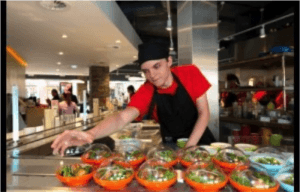 Image Credit: http://www.yosushi.com
Image Credit: http://www.yosushi.com
STATS
- Almost $56,000 saved on employee hygiene training costs by instituting a consistent online training program
12. Pat & Oscar’s E. coli Bankruptcy
California restaurant chain Pat & Oscar’s experienced an E. coli outbreak in its restaurants in 2003 when 40-plus guests fell ill. The restaurant rapidly apologized, but sales dropped off 70 percent immediately after the outbreak.
Pat & Oscar’s used a crisis management company to strategize immediate actions. The chain offered free meals to guests in the wake of the outbreak, set up a toll free number for people to call to report any suspicions they were affected, and fired the supplier that had sold them the lettuce that was responsible for the outbreak. The free food giveaway brought long lines and good press coverage with its “breadstick diplomacy” (named after the chain’s signature food). It also increased ad spending.
However, Pat & Oscar’s eventually declared bankruptcy following its restaurant crisis communications challenge. Many of the restaurants were later bought by former franchisees and collectively renamed O’s American Kitchen to distance them from the E. coli scare.
STATS
- $500,000 in free food given out over one weekend after the outbreak to win back guests
- Same-store sales fell 13.6 percent in 2004 following the outbreak
- $300,000 remodel for one converted O’s American Kitchen restaurant from the old Pat & Oscar’s brand
13. “McLibel Case
Historically it’s much easier to prove libel in Britain than the U.S. McDonald’s Corp. had successfully prosecuted people in the U.K. for libel before suing two environmental activists for the 1986 publication of an anti-McDonald’s brochure.
This case however carried on for years and became known as one of the worst PR disasters for McDonald’s. Instead of dropping the case against the duo, the franchise ended up increasing the negative publicity exposure of the brochure and looking like Goliath going after David.
A judge ruled in McDonald’s favor in 1997, but not before calling out the corporation for cruelty to animals, exploitation of children, misleading advertising and paying low wages in his verdict.
STATS
- Case became longest trial in British history, lasting 313 days
- McSpotlight website on the case accessed 184,675,000 times by summer 2003
- McDonald’s legal fees in the millions of dollars
14. Burger King Sells Horsemeat Burgers
When news of the widespread 2013 horsemeat scandal first broke, Burger King had quickly announced its burgers were untouched by the trouble. It was eating its words soon after however when tests revealed traces of horsemeat in some of its UK and Ireland patties.
Social media backlash was fast and furious, with thousands of anti-Burger King postings. BK’s vice president of global quality apologized saying, “While the Food Safety Authority of Ireland has stated that this is not a food safety issue, we are deeply troubled by the findings.” The company placed ads in several British newspapers apologizing. Burger King fired its meat supplier, assuring the public it would make sure all its future beef sources were British based. More troubling though was that Burger Kind had to retract an initial statement.
STATS
- Burger King’s “buzz score,” or perception of the brand, fell with UK consumers from 2 to -15 and with the overall brand from -8 to -18
15. Ikea Restaurant Food Troubles
IKEA doesn’t just sell minimalistic and affordable furniture worldwide. It’s also known for its restaurants, cafes and food products. However in 2013, during the horsemeat supplier scandal that spread through many countries, IKEA discovered that some of its famous Swedish meatballs had used some of the offending horsemeat. The meatballs were pulled from markets worldwide immediately. IKEA released a statement quickly, saying, “We do not tolerate any other ingredients than the ones stipulated in our recipes or specifications, secured through set standards, certifications and product analysis by accredited laboratories.”
The meatballs were returned to markets in March with IKEA proclaiming reforms from “farm to fork.” But IKEA has had further supplier issues as it examined its food. Its cake was found to be contaminated with sewer bacteria in March, and in April, a newspaper revealed that traces of pork were found in its moose lasagna and had been pulled from stores the prior month.
On the one hand, it was proactive of IKEA to quickly examine its food sources for contaminates. But multi-month revelations of “gross” things in IKEA restaurant food meant a negative publicity blitz. And IKEA only copped to the lasagna incident after a newspaper published a story about it.
STATS
- IKEA dropped 8 of 15 suppliers after horsemeat incident
- 23 countries had IKEA cake recall
- Estimated 150 million IKEA meatballs consumed worldwide
- 5 percent of IKEA’s $35.6 billion revenue comes from food sales
16. Vitello’s Business Increases After Murder
An established Studio City Italian eatery, found itself in the news in 2001 after actor Robert Blake and his wife Bonny Lee Bakley dined at the restaurant immediately before she was found shot nearby. Blake, who was acquitted of her murder but later lost a civil suit, claimed he couldn’t have killed his wife because he’d left a gun in a booth in Vitello’s that he’d gone back for at the time his wife was shot.
The Hollywood-related murder meant a morbid increase in business for Vitello’s after the Blake incident, but probably not for the reasons the restaurant wanted. Crime scene tour buses frequently drove past and diners came in wanting to sit in Blake’s booth. Vitello’s was sold in 2005 for $3.1 million. The new owner did a complete overhaul design and menu overhaul in 2012 to try and distance the restaurant once and for all from the Blake killing.
 Image Credit: http://www.vitellosrestaurant.com
Image Credit: http://www.vitellosrestaurant.com
STATS
- 20 percent increase in business reported after the murder
- The reported eBay auction starting price for the booth Blake and his wife were sitting in before she was killed nearby was $1,000. Vitello’s planned to auction it off in Aug. 2012 after renovations.
17. Sizzler Rat Poisoning Hoax
In 2006, rat poison pellets were found in pasta, soup and salad bar items at several Australian Sizzler restaurants. Though a woman was soon arrested and put in a psychiatric facility (and later escaped), Sizzler closed all of it 28 restaurants’ salad bars, which are a signature aspect of the restaurant chain.
However the Queensland health minister criticized the restaurant chain for taking 37 days to report the contamination issue to authorities. Sizzler had sent pellet samples for testing prior to notifying the health department. A law was soon after passed requiring restaurants to report a suspected contamination incident within 24 hours or be fined $15,000.
Sizzler Australia put extra salad bar security measures in place afterwards, including cameras and employees watching food and restaurant managers doing random taste tests and checks.
STATS
- Salad bars close for a week with company estimating losses in the “hundreds of thousands of dollars each day”
- Several million estimated in lost revenue from closure of popular salad bars, which are 60 percent of Sizzler Australia’s revenue
- Undisclosed investment in security cameras and supervisor watch time
18. Brown’s Chicken Mass Murder Leads to Bankruptcy
After seven people, including the store’s owners, were murdered during a 1993 robbery of the Palatine, Illinois, branch of Brown’s Chicken, the Chicago-based chain struggled to remain solvent after guests were scared away. The Palatine restaurant was torn down and a wave of Brown’s Chicken stores also closed.
It took a decade for the killers to be arrested. Brown’s sales dipped again around their trial time. Brown’s majority owner Frank Portillo fought back by speaking out at community events, joining anti-crime groups, donating to nonprofits, and increasing security training and installing security cameras at every one of his franchises.
A lawsuit battle between Portillo and a minority-share owner led to the company filing for bankruptcy in 2009 and the chain being auctioned off. Today it has 32 stores under the new owner and understandably makes no reference to the murders. But the ’93 murders have now become known as the Brown’s Chicken Massacre.
STATS
- 100 of 150 restaurants closed in wake of murders
- 35-40 percent sales drop in Chicago area after murders
- $585,000 – amount chain sold for in 2010
Benihana Kuwait Sues Customer for Bad Review
Here’s one way to win over no customers: sue someone for posting a mildly negative review. That’s what happened with Benihana’s Kuwait restaurant in 2011 when a Lebanese restaurant visitor left a review online saying the restaurant’s chicken was chewy and he wouldn’t return. Benihana’s responded back threatening legal action, something that is easier to pursue in Kuwait.
Benihana did take the blogger to court for $18,000 in damages. The blogger lost on appeal and was told to pay $3,600. But the restaurant has lost more than that amount in court fees and negative press after the incident became public.
STATS
- 5,200-plus mentions of the case on Twitter between Jan. 30-Feb. 15, 2011 according to The Rights Lawyers and Action Global Communications/Clique Social
- In 800 sample social media postings, 164 of them mentioned “boycott”-ing the chain
20. Subway Footlong Misses the Measure
Need another example of how you shouldn’t toy with your restaurant’s most popular items? In early 2013, an Australian Subway guest posted a Facebook picture of his Subway footlong with a ruler on top showing the sandwich was short of a foot. Similar measuring photos popped up worldwide on social media as people began complaining that the sandwich chain’s footlongs were inadequate in length. A handful of lawsuits were soon filed over the false advertising.
Subway initially protested that the name was just that and not an actual measurement. It also said that bread baking inconsistencies could also be at fault. But the negative coverage continued, including from U.S. television personality Stephen Colbert. The company was soon pledging to increase its sandwich size to the accurate foot-long dimensions. The restaurant quickly realized the power of social media in this case, as news from Australia spread to the U.S. and worldwide in a matter of days.
STATS
- 12 inches = foot
- 11 inches = average size of footlongs people were finding as “the footlong scandal” broke
- Subway has 38,000 restaurants in 100 countries where bread is baked fresh
21. Yum! China Struggles with Chicken and Mutton Scares
Food safety issues recently hit Yum! Brand, China, which owns KFC, Taco Bell, Little Sheep and other restaurant chains in China – in particular its KFC restaurants. The chicken chain has been the brand’s top moneymaker in China and had a huge grasp on the country’s fast food market until recently. KFC was called out for dangerous antibiotic levels in its chicken supply in December 2012. Sales fell 20 percent in China KFC’s first quarter of 2013 due to the scandal and avian flu worries. Sales had begun to recover by June.
The company was not fined for the antibiotic levels, but received lots of negative press and social media coverage. Yum! apologized in January for the food issues. It took them another month to announce it would begin “an aggressive marketing campaign” to revive KFC’s image.
Yum!’s Little Sheep hot pot chain also tried to ward off any whiff of scandal in May saying that none of its mutton supply was among the fake mutton found in the country recently.
STATS
- Yum! Brand had three straight quarters of lower earnings due to KFC scare
- Yum shares were down 63 cents on the NYSE in May due to the food supply scandal and avian flu worries
- 75 percent of Yum! Brands 6,000 China restaurants are KFC’s
22. Chipotle’s Food Safety & Better Burger Fiasco
Between July 2015 and April 2016, Chipotle had six (6) food safety scares, including cases of norovirus, E. coli, and salmonella across the country from Seattle to Boston. The news of the breaches in food safety did a number on the company’s stock performance, resulting in a loss of more than $11 billion in market capitalization.
In response to the food safety scares, the company did not explain (quickly enough) the steps it was taking to correct the issue, and closed all of its stores for a half day to have a “town hall” meeting to discuss changes that would be rolled out at all stores. Steve Ells then made an appearance on the Today show on NBC apologizing and saying Chipotle would become the “safest place to eat” – a tough claim to back up for a 2,000+ unit chain.
Not long after the food safety scandals, in late March 2016, Chipotle issued a trademark application for “Better Burger” – a name that is commonly used to describe a whole category of restaurants. The timing of the announcement was suspicious and could be seen as an attempt to distract away from the negative attention the brand had been receiving.
To add to the smoke and mirrors, the company then released its “A Love Story” video in July 2016, which – on the surface – seemed like a cute tale of young love, but was really just a (not-so) veiled attack of its competitors. Rather than take responsibility for its actions and make efforts to correct the food safety (and other) blunders, the company lashed out at its “big guy” competitors and tried to make them seem like the villain.
STATS
- More than 200 Chipotle customers were affected by the different food safety cases
- At the time, Chipotle’s loss in market capitalization was larger than the combined value of the two largest publicly traded casual dining companies (Darden and Brinker, with market capitalizations of $8.47 billion and $2.65 billion, respectively)
- The “A Love Story” video reached more than six million views on YouTube within just three weeks of being released
Key Takeaways on Restaurant Crisis Communications
What can you do to prevent ending up like one of the companies discussed here?
Be Ready: Eric Holm probably never dreamed he’d be thrust into the national spotlight by one of his line-level employees. Don’t be caught in a situation like Golden Corral and others did. Create a plan now, and implement it when the time comes.
Respond — FAST: Guests and journalists are an impatient bunch. Speak on your own behalf or they’ll find someone else to do it for you—and not very favorably.
Nix the “No Comment:” Buy time instead; work with a pro to tackle the tough issues. But never say “no comment.” When you do, the media knows you’re running scared. To them, it’s an admission of guilt.
Ask for Help: Seriously, defer to the pros. It takes decades to build a reputation and seconds to destroy it. Invest in managing your crisis. It will be the best money you ever spent.
Have a Plan: We’re not talking about fleeing the country, although it’s tempting. Institute a Crisis Communication Plan — now, while things are calm. It doesn’t need to be pages long; even a one-page blueprint will suffice. You need a clear internal policy that employees can follow when the yucky stuff hits the fan. We’re talking phone numbers, contact names, agreed-upon procedures. Make sure all of your employees know the plan so you can, at the very least, prevent an immediate downward spiral.
Monitor your reputation: Invest in a reputation monitoring service. Social applications and smartphones allow people to spew both good and bad. Since technology operates at warp speed, you need to know what’s being said about your brand in real-time. You could be doing something to alienate clientele without even knowing it. Not having a monitoring service is the equivalent of a modern military without radar. You’re blind, vulnerable and almost always blindsided by an attack. It’s ill-advised.
It’s Not about IF, but WHEN: Crisis Communication is anything but boring. For a long time, the subject conjured images of stodgy books and lectures — the ramblings of worrywarts. But, now, consider just how fast a decades-old brand can unravel; it’s terrifying! Technology invites any disgruntled employee or customer to cause serious damage with one post or video. The digital era has intensified the stakes and complexity of crisis communications. You must have a plan. It’s not about IF you’ll have a crisis, but WHEN. Crisis management training is a requirement for the modern restaurant CEO.

